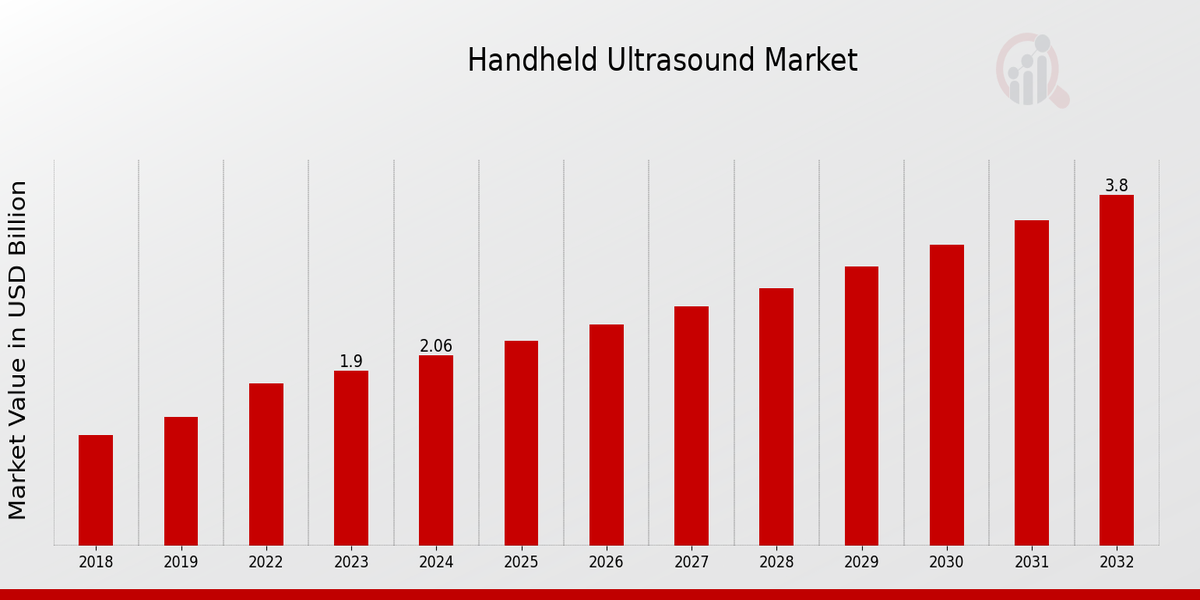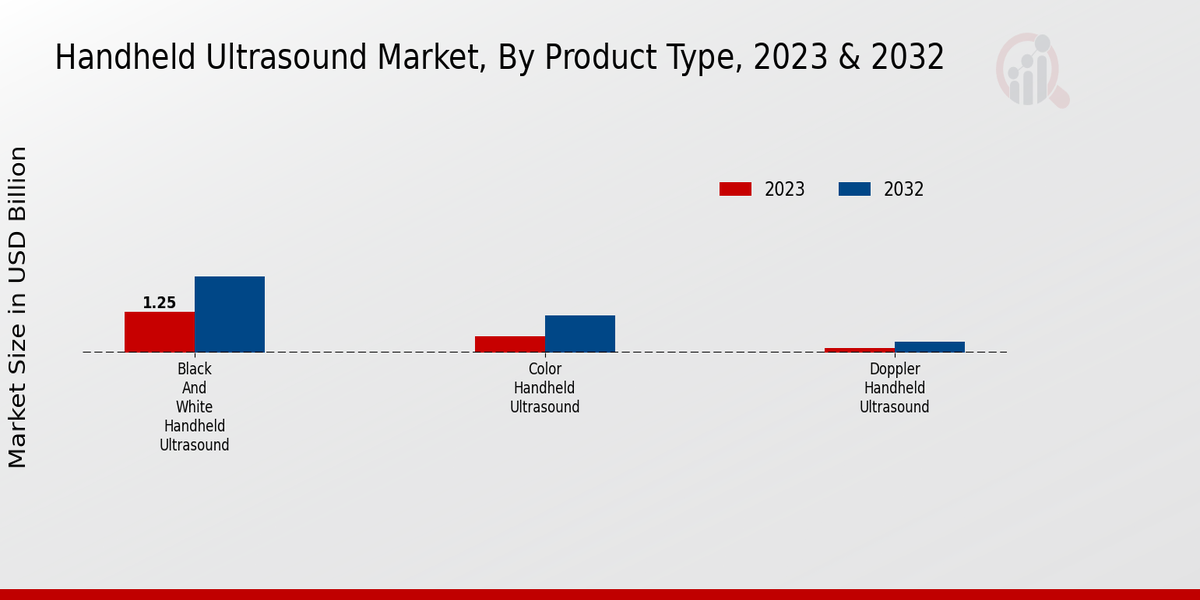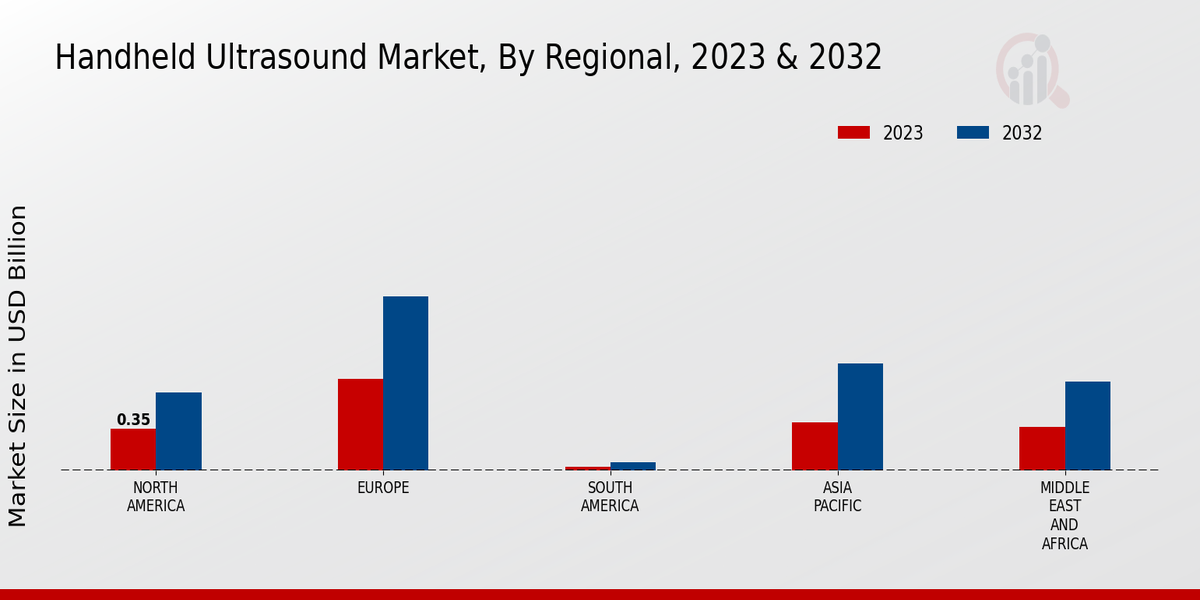Global Handheld Ultrasound Market Overview
As per MRFR analysis, the Handheld Ultrasound Market Size was estimated at 0.21 (USD Billion) in 2023.
The Handheld Ultrasound Industry is expected to grow from 0.22 (USD Billion) in 2024 to 0.31 (USD Billion) by 2032. The Handheld Ultrasound Market CAGR (growth rate) is expected to be around 4.27% during the forecast period (2024 - 2032).
Key Handheld Ultrasound Market Trends Highlighted
The global handheld ultrasound market exhibits promising growth prospects, driven by advancements in medical technology and the increasing demand for point-of-care ultrasound examinations. Key market drivers include the growing prevalence of chronic diseases, the rising incidence of trauma and emergency cases, and the expansion of minimally invasive procedures. Opportunities for market growth lie in the integration of artificial intelligence (AI) and machine learning (ML) to enhance image quality and diagnostic capabilities. Recent trends include the development of wireless and portable handheld ultrasound devices, enabling real-time imaging in diverse care settings.
Furthermore, the market is witnessing the emergence of mobile applications connected to handheld ultrasound devices, facilitating remote consultations and patient monitoring.

Source: Primary Research, Secondary Research, Market Research Future Database and Analyst Review
Handheld Ultrasound Market Drivers
Technological Advancements
The market for handheld ultrasound is driven by constant advancements in ultrasound technology. The wonders of ultrasound device development include ultrasound imaging advances that provide even more detailed and accurate images of the body, such as 3D and 4D ultrasound techniques. Moreover, miniaturized ultrasound transducers have led to the development of even smaller and more handheld portable ultrasound devices, which make the ultrasound examination even more convenient.
In general, technological advancement and resulting ultrasound developments have had the most significant effect on the large expansion of all the potential application fields for ultrasound examination, including the use of handheld devices in numerous medical fields.
Rising Prevalence of Chronic Diseases
The increasing prevalence of chronic diseases, such as cardiovascular disease, cancer, and diabetes, is another major driver of the handheld ultrasound market. Handheld ultrasound devices are increasingly used for the diagnosis and management of these diseases. For example, handheld ultrasound can be used to assess heart function, detect tumors, and monitor blood flow in patients with diabetes. The rising prevalence of chronic diseases is expected to continue to drive the demand for handheld ultrasound devices in the coming years.
Growing Demand for Point-of-Care Ultrasound
Handheld ultrasound devices are becoming more popular because of the increased demand for point-of-care ultrasound. Point-of-care ultrasound involves the use of ultrasound equipment in non-traditional healthcare settings, such as clinics, emergency departments, and even patient homes. Since handheld ultrasound devices are portable and easy to use, they are well-suited for point-of-care use. Therefore, the growing adoption of point-of-care ultrasound will continue to drive the demand for handheld ultrasound devices in the foreseeable future.
Handheld Ultrasound Market Segment Insights
Handheld Ultrasound Market Product Type Insights
The segmentation by product type in the Global Handheld Ultrasound Market includes black and white handheld ultrasound, color handheld ultrasound, and Doppler handheld ultrasound. It is projected that the color handheld ultrasound segment will dominate the market and be the highest revenue generator in 2023. The growing adoption of color handheld ultrasound devices in several clinical applications such as abdominal imaging, cardiac imaging, obstetrics and gynecology is driving the growth of this segment.
The black-and-white handheld ultrasound segment is expected to rise at a steady CAGR since black-and-white handheld ultrasound devices are affordable, easy to use, and highly portable, making them very suitable to be used in remote and poor areas with limited resources.
The Doppler handheld ultrasound segment is anticipated to rise at a moderate rate. Doppler handheld ultrasound devices are used for vascular imaging and provide valuable information on blood movement patterns. The increasing use of handheld Doppler ultrasound in cardiovascular diagnostics is responsible for the growth of the Doppler handheld ultrasound. Overall, the Global Handheld Ultrasound Market is projected to grow at a significant CAGR in the future due to the rising prevalence of chronic diseases and the demand for point-of-care diagnostics and continuous technological innovations in handheld ultrasound.
Global Handheld Ultrasound Market, by Product Type 2023 & 2032 (USD Billion)

Source: Primary Research, Secondary Research, Market Research Future Database and Analyst Review
Handheld Ultrasound Market Application Insights
Based on application, the Global Handheld Ultrasound Market is segmented into Emergency Medicine, Point-of-Care Ultrasound, Veterinary Medicine, and Obstetrics and Gynecology. Emergency Medicine is expected to occupy a prominent share of the Global Handheld Ultrasound Market revenue in 2023 as there is growing adoption of handheld ultrasound devices for rapid and accurate diagnosis. Point-of-Care Ultrasound segment is expected to grow at a significant rate during the forecast period, as there is a rise in demand for real-time imaging in various clinical settings.
The Veterinary Medicine segment is expected to grow significantly as there is an increase in the adoption of handheld ultrasound devices for animal diagnostics. Obstetrics and Gynecology segment is expected to hold a significant share of the market, as there is growing use of handheld ultrasound devices for prenatal imaging and monitoring.
Handheld Ultrasound Market End User Insights
The Global Handheld Ultrasound Market Segmentation by End User shows high potential in various healthcare settings, including hospitals, emergency medical services, clinics, and ambulatory surgery centers. Hospitals are expected to dominate the market with a significant share, owing to the increasing adoption of handheld ultrasound devices for point-of-care diagnostics and emergency procedures. The Global Handheld Ultrasound Market data indicates that hospitals will contribute a substantial revenue in 2024. Emergency medical services are also witnessing growing demand for handheld ultrasound devices for rapid and portable imaging in pre-hospital settings.
Clinics and ambulatory surgery centers are also emerging as promising segments, driven by the need for cost-effective and efficient imaging solutions.
Handheld Ultrasound Market Probe Technology Insights
Probe technology is a key market segment, with different types of probes offering unique features and applications. Linear probes, with their flat and elongated shape, provide excellent image quality and are commonly used in superficial imaging applications such as vascular imaging and musculoskeletal exams. Sector probes, characterized by their curved shape, offer a wider field of view and are suitable for deeper imaging applications such as abdominal and cardiac examinations. Curved probes, with their convex shape, provide a balance of image quality and field of view, making them ideal for a variety of applications, including obstetrics, gynecology, and urology.
The choice of probe technology depends on the specific clinical application and the desired image quality and field of view. The Global Handheld Ultrasound Market is expected to grow significantly in the coming years due to the increasing adoption of handheld ultrasound devices in various clinical settings, technological advancements, and rising demand for portable and cost-effective imaging solutions.
Handheld Ultrasound Market Technology Type Insights
The market is segmented based on technology type into analog handheld ultrasound and digital handheld ultrasound. Analog handheld ultrasound systems are less expensive and portable than digital systems, making them more accessible for use in remote areas. Digital handheld ultrasound systems offer a wider range of features and higher image quality than analog systems, making them more suitable for use in critical care settings. The global handheld ultrasound market is expected to be driven by the increasing demand for minimally invasive procedures, the growing prevalence of chronic diseases, and the rising awareness of the benefits of ultrasound imaging.
Handheld Ultrasound Market Regional Insights
North America commands the largest regional share in the Handheld Ultrasound Market in 2023 due to rising prevalence of chronic diseases, increasing demand for point-of-care diagnostics, and technological advancements in handheld ultrasound devices. Europe holds the second position in the market owing to the high adoption of advanced healthcare technologies, favorable reimbursement policies, and growing awareness about the benefits of handheld ultrasound. APAC is expected to register the highest CAGR during the forecast period due to increasing healthcare expenditure, urbanization, and rising demand for affordable and accessible healthcare solutions.
South America and MEA have relatively smaller market shares but are expected to witness significant growth in the coming years due to improving healthcare infrastructure and government initiatives to improve healthcare access.
Global Handheld Ultrasound Market, by Region 2023 & 2032 (USD Billion)

Source: Primary Research, Secondary Research, Market Research Future Database and Analyst Review
Handheld Ultrasound Market Key Players And Competitive Insights
The main players in Handheld Ultrasound Market are inclined to gain a foothold by means of product development and innovations, business cooperation and mergers or sales. The main players of Handheld Ultrasound Market are aimed at product range extension. Moreover, manufacturers of Handheld Ultrasound are investing funds in research and development, which must contribute to an increase in accuracy, portable and easy usage.
In addition, business cooperation and mergers or acquisitions are actively implemented by manufacturers of Handheld Ultrasound in order to broaden business connections and eventually gain a foothold in a new market or supplement technical expertise or object of production. In this way, the Handheld Ultrasound Market will be represented by vigorous competition from new entrants and market players. To be more exact, major players in the Handheld Ultrasound Market are FUJIFILM SonoSite, Inc., GE Healthcare and Philips.
FUJIFILM SonoSite, Inc. is a global manufacturer of ultrasound products meant to facilitate medical examination and prevent deceases at primary stages. The company’s regional enlargemen has enabled the company to become a key in Handheld Ultrasound Market. High-quality imaging and easy usage and portability may be implemented as key features of FUJIFILM SonoSite, Inc.’s products. Moreover, the company has broad distribution channels.
GE Healthcare is a global leader in innovative medical solutions. GE Healthcare provides Handheld Ultrasound products suited for clinical occasions, such as emergency medicine, critical care, and point of care. GE Healthcare is inclined to develop advanced ultrasound technologies capable of improving patients’ lives and lowering healthcare costs. GE Healthcare has a broad range of innovations and, therefore, is capable of maintaining leadership in the Handheld Ultrasound Market.
Key Companies in the Handheld Ultrasound Market Include
- GE Healthcare
- Clarius
- Bmode Ultrasound
- Analogic
- Fujifilm SonoSite
- Mindray
- Toshiba
- Hitachi
- Philips
- Samsung Medison
- Siemens Healthineers
- Zonare Medical Systems
- Butterfly Network
- Comed
-
Handheld Ultrasound Market Industry Developments
-
Q2 2024: Handheld Ultrasound Market Round-up The Exo Iris handheld ultrasound device launched as a new market entrant, offering phased array, curvilinear, and linear probe settings with a single transducer, marking a significant product launch in the handheld ultrasound sector.
Handheld Ultrasound Market Segmentation Insights
Handheld Ultrasound Market Product Type Outlook
- Black and White Handheld Ultrasound
- Color Handheld Ultrasound
- Doppler Handheld Ultrasound
Handheld Ultrasound Market Application Outlook
- Emergency Medicine
- Point-of-Care Ultrasound
- Veterinary Medicine
- Obstetrics and Gynecology
Handheld Ultrasound Market End User Outlook
- Hospitals
- Emergency Medical Services
- Clinics
- Ambulatory Surgery Centers
Handheld Ultrasound Market Probe Technology Outlook
- Linear Probe
- Sector Probe
- Curved Probe
Handheld Ultrasound Market Technology Type Outlook
- Analog Handheld Ultrasound
- Digital Handheld Ultrasound
Handheld Ultrasound Market Regional Outlook
- North America
- Europe
- South America
- Asia Pacific
- Middle East and Africa
| Report Attribute/Metric |
Details |
| Market Size 2023 |
0.21 (USD Billion) |
| Market Size 2024 |
0.22 (USD Billion) |
| Market Size 2032 |
0.31(USD Billion) |
| Compound Annual Growth Rate (CAGR) |
4.27% (2024 - 2032) |
| Report Coverage |
Revenue Forecast, Competitive Landscape, Growth Factors, and Trends |
| Base Year |
2023 |
| Market Forecast Period |
2024 - 2032 |
| Historical Data |
2019 - 2023 |
| Market Forecast Units |
USD Billion |
| Key Companies Profiled |
GE Healthcare, Clarius, Bmode Ultrasound, Analogic, Fujifilm SonoSite, Mindray, Toshiba, Hitachi, Philips, Samsung Medison, Siemens Healthineers, Zonare Medical Systems, Butterfly Network, Comed, Esaote |
| Segments Covered |
Product Type, Application, End User, Probe Technology, Technology Type, Regional |
| Key Market Opportunities |
Increasing adoption in poin[-to-care settings Technological advancements Rising demand for emergency and critical care applications |
| Key Market Dynamics |
Growing adoption in point-to-care settings Advancements in technology and imaging capabilities Increasing prevalence of chronic diseases Rising demand for minimally invasive procedures Expanding applications in veterinary medicine |
| Countries Covered |
North America, Europe, APAC, South America, MEA |
Frequently Asked Questions (FAQ):
The Global Handheld Ultrasound Market is expected to reach USD 0.31 billion by 2032, exhibiting a CAGR of 4.27% during the forecast period 2024-2032.
North America is expected to dominate the Global Handheld Ultrasound Market throughout the forecast period. Factors such as the presence of a large number of market players, well-established healthcare infrastructure, and increasing adoption of advanced technologies contribute to the region's dominance.
Key applications of Handheld Ultrasound include point-of-care diagnostics, emergency medicine, anesthesia, and pain management. It is also used in various surgical procedures such as vascular access, nerve blocks, and biopsies.
Key competitors in the Global Handheld Ultrasound Market include GE Healthcare, Koninklijke Philips N.V., Siemens Healthineers, FUJIFILM SonoSite, Inc., and Mindray Medical International Limited.
Major factors driving the growth of the Global Handheld Ultrasound Market include the increasing prevalence of chronic diseases, rising demand for minimally invasive procedures, technological advancements, and growing awareness of the benefits of handheld ultrasound.
Challenges faced by the Global Handheld Ultrasound Market include reimbursement issues, the high cost of devices, and the lack of skilled professionals in some regions.
Opportunities for growth in the Global Handheld Ultrasound Market lie in the expansion of applications in various medical fields, the development of new and innovative technologies, and the increasing demand for handheld ultrasound in developing countries.
Key trends in the Global Handheld Ultrasound Market include miniaturization of devices, wireless connectivity, and the integration of artificial intelligence (AI) for image analysis and interpretation.
The COVID-19 pandemic had a positive impact on the Global Handheld Ultrasound Market. The increased demand for point-of-care diagnostics and remote patient monitoring during the pandemic drove market growth.
Handheld Ultrasound devices are regulated as medical devices in most countries. Regulatory bodies such as the US Food and Drug Administration (FDA) and the European Medicines Agency (EMA) have established guidelines for the approval and use of these devices.

















